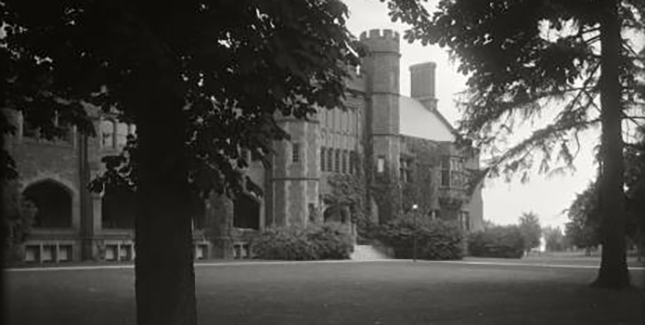The Role of the Alumnae Association
In the summer of 1969, president of the Alumnae Association, Barbara Waugh Stephenson ’45, wrote an article for the Alumnae Quarterly addressing issues such as censorship, freedom of speech, and increases in the cost of education. In the article, transcribed in its entirety here, Stephenson also makes note of the need for recent graduates to participate in the Alumnae Association and describes her goals for the Association, including how she plans to make them a reality.
The Alumnae Association
At a time when roles are being redefined, policies restated and rules revised, how can the Alumnae Association serve the best interests of the College? Central to the modus operandi is always the stated purpose “to advance the interests of Mount Holyoke College and to cooperate in its work.” With the knowledge that our College cannot exist as an isolated entity ‘midst the social and intellectual ferment of the country, what are the implications for support of this purpose? Discussion, decisions, and resulting activities sponsored by your Board of Directors have been closely related to these questions during the past year.
Recognizing the Quarterly as a fundamental tool for communication, the Board has supported the policy of editorial freedom to report controversial issues.
Primary attention has been given to keeping alumnae abreast of current information about Mount Holyoke. The position of interpreting accurately what is taking place in South Hadley and arranging informative programs, both on and off campus, of current interest, has led the Board to devote time to becoming acquainted with students and listening to their concerns. At the same time, faculty and administrative points of view have been heard. Recognizing the Quarterly as a fundamental tool for communication, the Board has supported the policy of editorial freedom to report controversial issues.
An integral part of our understanding of the issues being discussed as the College adjusts to the changing times has been the involvement of our professional staff in very close working relationships with the various constituencies of the College. Attendance at the professional meeting sponsored by the American Alumni Council by representatives of ideas at a meeting of Association Presidents and Alumnae Secretaries of the “Seven Sisters” this year have broadened our perspective relative to our own situation.
Two trends of recent years continue: to interest our youngest graduates to active participation and to involve alumnae from a wide variety of geographical locations. In an effort to match the alumnae program to the interests and needs of all alumnae, however, the Board is devoting considerable time to long-range planning.
Two trends of recent years continue: to interest our youngest graduates to active participation and to involve alumnae from a wide variety of geographical locations.
A concern for increasing the direct financial contributions to the College relative to the rising costs of education is constantly weighed against the requirements of financing a first class Alumnae Association operation. Competent professional staff and efficient up-to-date office equipment to implement policies and programs required by our members have been priority in determining budgetary allocations. The final audited financial statement for the fiscal year July 1, 1968–June 30, 1969, will be reported at the fall membership meeting and printed in the fall Quarterly.
In our gratitude for the patient and devoted attention given by faculty, administration, trustees and students toward keeping our alma matter in a position of leadership, let us, as informed and persuasive spokesmen, share in the responsibility to guarantee the Mount Holyoke way of education.
Barbara Waugh Stephenson ’45
President, Alumnae Association
View more content from the Winter 2017 100th anniversary issue of the Alumnae Quarterly.
December 19, 2016













Leave a Reply